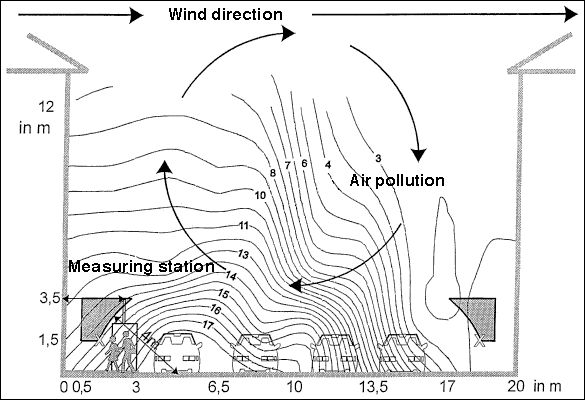Traffic-caused air pollution immission in canyon streets is modelled with the program segment IMMIScpb. It enables the calculation of hourly values of pollutant immissions produced by local traffic at any receptor in a canyon street with varying building heights and with spaces between buildings which allow the passage of wind, on the basis of easily accessible meteorological quantities. An additional required input quantity is the emission level for each section of the street. The emissions were calculated from the current traffic data using the program segment IMMISem. The pollution produced by the city is derived from the sum of the additional pollution measured using the canyon street model, the local street traffic, and the urban background pollution calculated using the IMMISnet program.
Update of the calculational basis for applying the model to the prognosis year 2015
Information on the actual motor vehicle fleet composition in Berlin was available from license-plate observations for the reference year 2012. In addition, information on the current and future fleet composition of the regular buses of the BVG was available. This information for 2012 was transferred to the reference years 2015 and 2020 using extrapolation factors.
The traffic volumes on Berlin’s primary roads were taken from the calculations for 2015 for the Air Quality Plan 2011-2017, as no newer values were available.
Moreover, background pollution values in the urban background were adapted for the recalculation. Thus, the decreasing trend of the urban NO2 background pollution that had had been assumed in 2009 in the prognosis up to 2015 is not discernible in the measurement data between 2009 and 2014. For 2015, the NO2 background value was derived from measurements and extrapolated up to 2020 using supraregional models from the UBA project “LUFT 2030” (UBA 2014).
The calculation of the motor vehicle emissions was carried out with the new emission factors based on the current UBA manual (Version 3.2).
Evaluation of the calculation results based on an index
The map drafted using this process shows the spatial distribution of traffic caused air pollution for NO2 and PM10. A summary assessment was conducted for both substances. The index developed weighs the calculated concentrations of both pollutants according to their limit values throughout the network of road sections of the primary roads network for 2015, which has been expanded to some 10,000 for this purpose, and adds the quotients. For example, if the two components both reach 50% of the limit, an index of 1.00 will result. All sections that show a reading in excess of 1.8 (90% or more of the limit value) will require special attention in future (cf. Effects on Human Health).
The approach used to calculate the number of residents affected by limit value exceedances was taken from the noise mapping procedure (see also Maps 07.05 Strategic Noise Maps). The number of residents in the flats facing the street front is counted. The number of citizens affected by limit value exceedances thus ascertained represents a rather conservative estimate, because the pollutants spread everywhere, so that increased concentrations can also occur outside highly polluted canyon streets.
Data display for the map Traffic-related Air Pollution
The data display in the Geoportal FIS Broker includes the following detailed information on the selected road section:
- Section Number
- Name of the road section
- Length of the road section [m]
- Average daily traffic volume (DTV) motor vehicles prognosis 2015
- Number of heavy trucks (> 3.5 t) per day prognosis 2015
- Number of light trucks (< 3.5 t) per day prognosis 2015
- Number of public transport buses per day prognosis 2015
- Number of motorcycles per day prognosis 2015
- Affected residents on the road section
- NO2 pollution (annual mean in µg/m3) prognosis 2015
- PM10 pollution (annual mean in µg/m3) prognosis 2015
- PM2.5 pollution (annual mean in µg/m3) prognosis 2015
- NO2 pollution (annual mean in µg/m3) prognosis 2020
- PM10 pollution (annual mean in µg/m3) prognosis 2020
- PM2.5 pollution (annual mean in µg/m3) prognosis 2020
- Air pollution index for NO2 referred to 2015
- Air pollution index for PM10 referred to 2015
- Overall air pollution index for NO2 and PM10 referred to 2015

